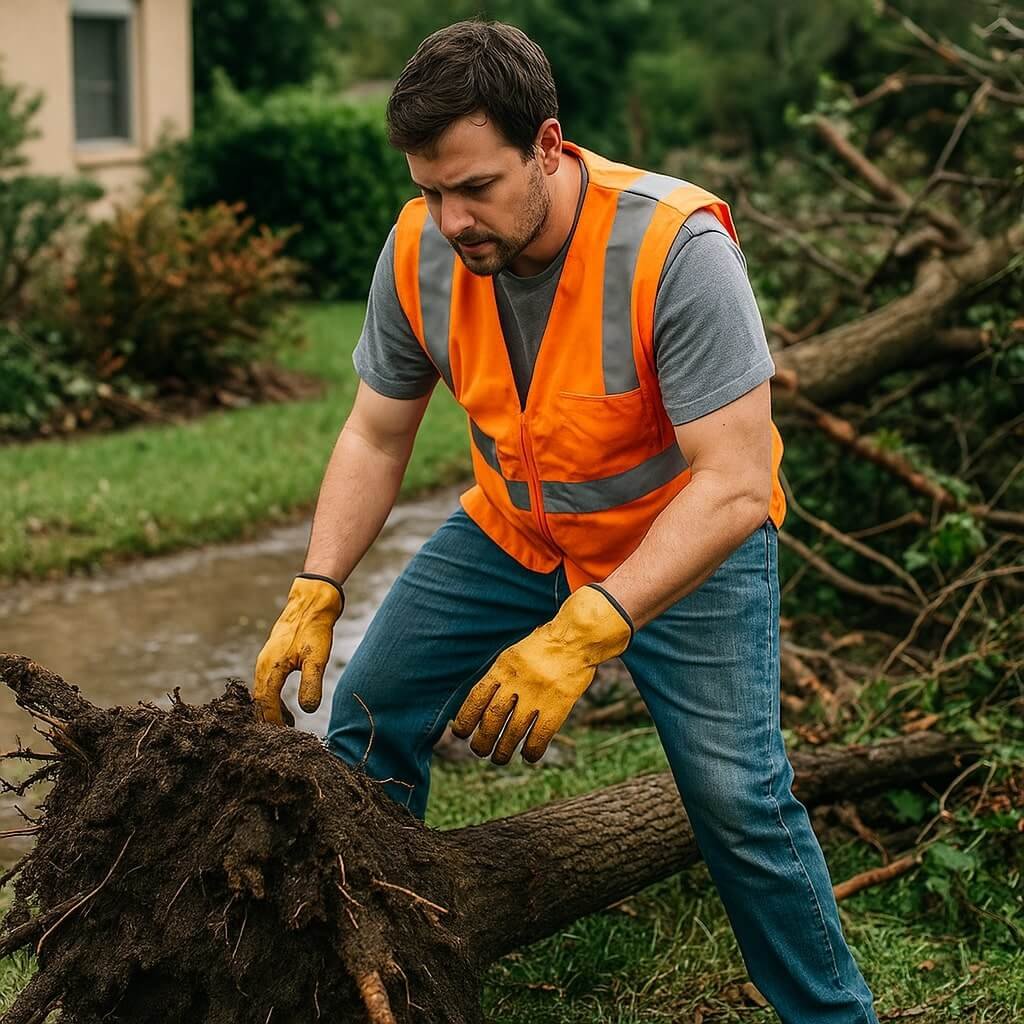What Qualifies as a Landscaping Emergency?
A landscaping emergency includes any sudden damage or change to your outdoor space that:
- Poses a safety risk
- Threatens property (like flooding or uprooted trees)
- Disrupts the appearance and function of your curb appeal
In short, if it needs fixing immediately to prevent bigger issues, it’s an emergency.
Why Immediate Action Matters in Landscaping
Ignoring a landscaping emergency—even for a few hours—can lead to long-term damage. For example:
- Water pooling can erode your soil and foundations
- Fallen branches can attract pests
- Uprooted plants may not survive if left out too long
Quick action not only minimises damage but also reduces your final repair costs.
Common Landscaping Disasters and Their Causes
Flash Flooding and Erosion
Floodwaters can reshape your entire yard in hours. Causes include:
- Poor drainage
- Blocked gutters
- Excessive rainfall
Wind Damage to Trees and Plants
Strong winds can:
- Snap branches
- Uproot shallow-rooted plants
- Scatter debris across your property
Pest Infestations
A sudden invasion of pests like beetles or grubs can decimate turf overnight. Warm weather and exposed soil are common culprits.
Emergency Landscaping vs. Regular Maintenance
While routine landscaping keeps your yard healthy and attractive, emergency landscaping is all about damage control. It’s fast-paced, solution-oriented, and often involves:
- Heavy machinery
- Specialist teams
- Rapid response times
Routine services focus on prevention. Emergency services focus on restoration and survival.
Top 7 Emergency Landscaping Services That Save the Day
1. Emergency Tree Removal
Dead, leaning, or broken trees are a hazard. Professional crews use cranes and saws to safely extract dangerous trees within hours.
2. Drainage Solutions
Improper drainage can cause root rot and basement leaks. Emergency drainage fixes may include:
- French drains
- Swales
- Redirecting downspouts
3. Sod and Turf Repairs
Waterlogged or pest-eaten grass can be patched with:
- Fresh sod
- Turf reseeding
- Soil grading
4. Rapid Mulching Services
Mulch isn’t just decorative—it protects roots, absorbs water, and reduces erosion. In emergencies, landscapers lay down heavy mulch to stabilise soil.
5. Erosion Control Measures
Techniques include:
- Retaining walls
- Straw wattles
- Geotextile fabric
These prevent hillsides from sliding and gardens from washing away.
6. Storm Cleanup Teams
From branches to shingles, storm debris creates chaos. Cleanup crews restore order using:
- Wood chippers
- Leaf vacuums
- Heavy-duty sweepers
7. Hardscape Stabilization
Loose pavers, broken walls, and cracked concrete can be fixed or replaced quickly to prevent injuries or further erosion.
Essential Tools for DIY Emergency Landscaping
Having the right gear can buy you precious time until the pros arrive:
- Shovels and spades
- Rakes and leaf blowers
- Emergency tarps
- Wheelbarrows
- Drainage pipes
While not a full solution, these tools help you contain the problem and prevent it from escalating.
When to Call the Professionals
Not every landscaping issue can be handled with elbow grease alone. Call in professionals if:
- Trees are threatening structures
- You lack the proper tools or knowledge
- There are electrical or plumbing risks involved
- The damage spans more than one area of your yard
How to Prepare Your Yard for Future Emergencies
Prevention is your best ally. Here’s how to prepare:
- Trim dead branches regularly
- Install proper drainage systems
- Use native plants that can withstand local climate extremes
- Create an emergency yard toolkit
Simple proactive steps today can save thousands tomorrow.
Cost Considerations and Budgeting Tips
Emergency landscaping can be pricey due to urgency, equipment, and labour. Here’s how to manage:
- Keep a “landscaping emergency” fund (aim for $500–$1000)
- Ask for itemised quotes
- Prioritise essential repairs
- Schedule follow-up work for non-urgent issues
Real-Life Emergency Landscaping Case Studies
Case 1: Tree vs. Roof (Florida)
A homeowner called in for emergency tree removal after a lightning strike split their oak tree. The crew arrived within 2 hours and prevented major structural damage.
Case 2: Backyard Lake (Texas)
After a pipe burst under a lawn, professional landscapers installed drainage and new turf in under 3 days, saving the home’s foundation.
Case 3: Hillside Collapse (California)
Following a landslide, a team installed retaining walls and erosion netting to stabilise the landscape within a week.
FAQs About Emergency Landscaping Help
How do I know if my landscaping issue is an emergency?
Will my homeowner’s insurance cover emergency landscaping?
How fast can emergency landscaping services respond?
Can I prevent all landscaping emergencies?
What should I do while waiting for emergency help?
Are emergency landscaping services more expensive than regular ones?
Conclusion: Stay Ready, Stay Safe
Landscaping emergencies strike without warning—but with the right preparation, response, and professionals, you can protect your home and restore beauty quickly. Whether it’s a fallen tree or a flooded lawn, remember: acting fast is the best landscaping insurance you can have.



